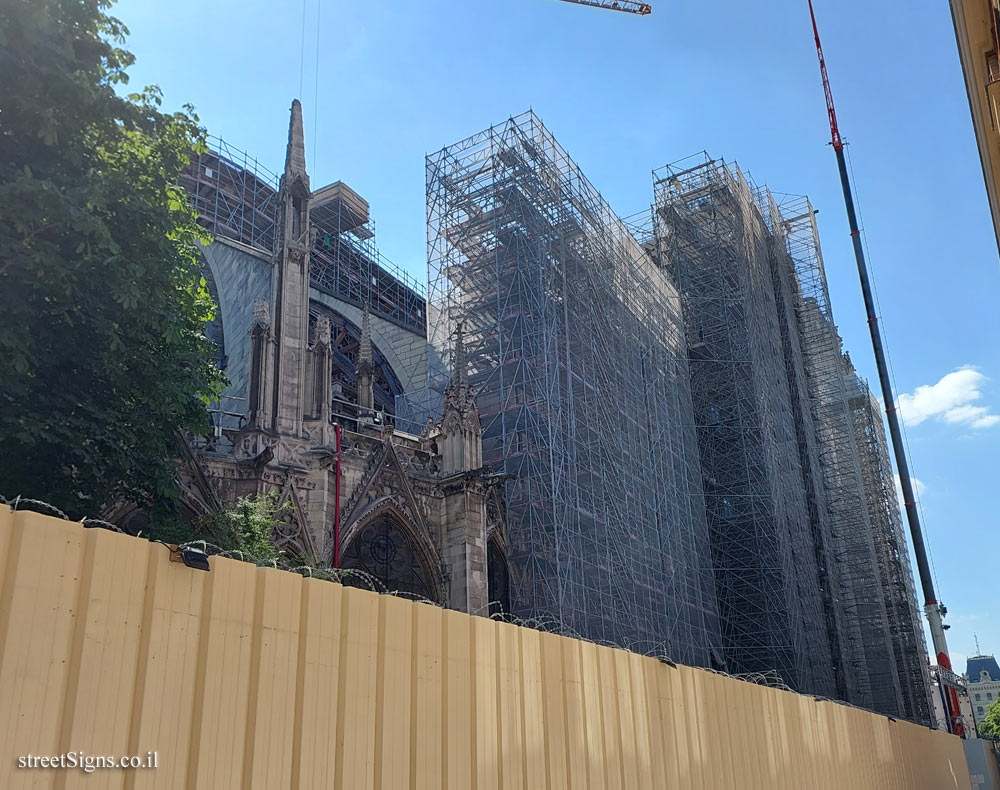Although it is likely that the sign is temporary, and there is a chance that it will be removed after the completion of the restoration of Notre Dame Cathedral after the great fire of 2019, the restoration project is a project of historical significance in light of the importance of the place and the scope of the project.
The cathedral during the restoration was photographed on the same day
 Click for a larger image
Click for a larger image  Click for a larger image Translation of the text on the sign
Click for a larger image Translation of the text on the sign:
Restoration project at Notre-Dame de Paris cathedral
The restoration project The fire of April 15, 2019 seriously affected Notre-Dame Cathedral in Paris. For a few hours, the whole world feared the complete disappearance of a remarkable monument, which then demonstrated the unparalleled place it occupies in the hearts of our contemporaries from all countries.
The spire, the entire roof (frame and covering) and part of the vaults of the main vessel were destroyed. The masonry of the upper parts and the interior fittings of the cathedral were profoundly altered by the fire even if most of the works of art were fortunately spared.
The work to secure the cathedral was initiated the day after the disaster and was completed in September 2021: It made it possible to eliminate any risk of the monument collapsing and made it possible to access the damaged parts of the cathedral. to carry out restoration operations.
At the same time, the public establishment responsible for the conservation and restoration of Notre-Dame de Paris Cathedral (RNDP), project manager, and the architects of historic monuments, project managers, carried out the work in 2020. restoration studies of the building with a view to its reopening for worship and visits in 2024. The restoration party received a unanimously favorable opinion from the national commission for heritage and architecture and heritage during its examination on July 9, 2020 and was validated by the State services responsible for historic monuments in accordance with the heritage code. Restoring the spire of Viollet-le-Duc and the attic lost in the flames, restoring the architecture affected by the fire, it will allow all the faithful and visitors from the entire world to find in 2024 the cathedral they love, in accordance with to the objective set by the President of the Republic.
The restoration is now undertaken by the public establishment and the project management. To restore the masonry of the upper parts of the cathedral destroyed by the fire, restore the framework and roof of the medieval attic as well as the emblematic spire of Viollet-le-Duc, more than 1000 m3 of stone and 2000 oaks are necessary. The interior elevations of the cathedral and the floors are completely cleaned and restored, as well as the numerous decorations which adorn the building. The cathedral’s fire protection has been completely redesigned, integrating all the desirable provisions for fire prevention, detection and fighting. The technical networks are taken over in full, with a view to optimal functioning of the cathedral reopened for worship and visits. Restoration includes eight main components:
• Restoration work on the spire and transept
•Restoration work on the choir and nave
• Thorough cleaning work of the interiors relating to the monument (floors and elevations) which will include the restoration of the upper bays and stained glass windows
• Thorough cleaning of the interiors relating to the furniture and works of art attached to the cathedral (stalls, pulpit, organ gallery, wish of Louis XIII, etc.)
• Work related to technical installations (fire safety, high currents, low currents, heating, ventilation,)
• Work relating to the restoration of the belfries in the towers of the western massif and the improvement of the tour circuit of the towers
• Restoration work on the grand organ, including its case
• Site installations (cranes and lifting means, base camp, scaffolding).
Since the start of 2022, this work has involved several dozen companies across France. They will be carried out mainly on the site itself, with certain preparatory tasks also being carried out in the workshop, whether this involves pre-assembly or pre-shaping of certain works, or restoration of easily movable elements such as pipes of the great organ.
This work is entirely financed by the generosity of 340,000 French and foreign donors who have mobilized to contribute to the rebirth of Notre-Dame de Paris cathedral.
We are all collectively indebted to them for the recovery of the cathedral. May they be very warmly thanked here.

 Click for a larger image
Click for a larger image  Click for a larger image
Click for a larger image